|
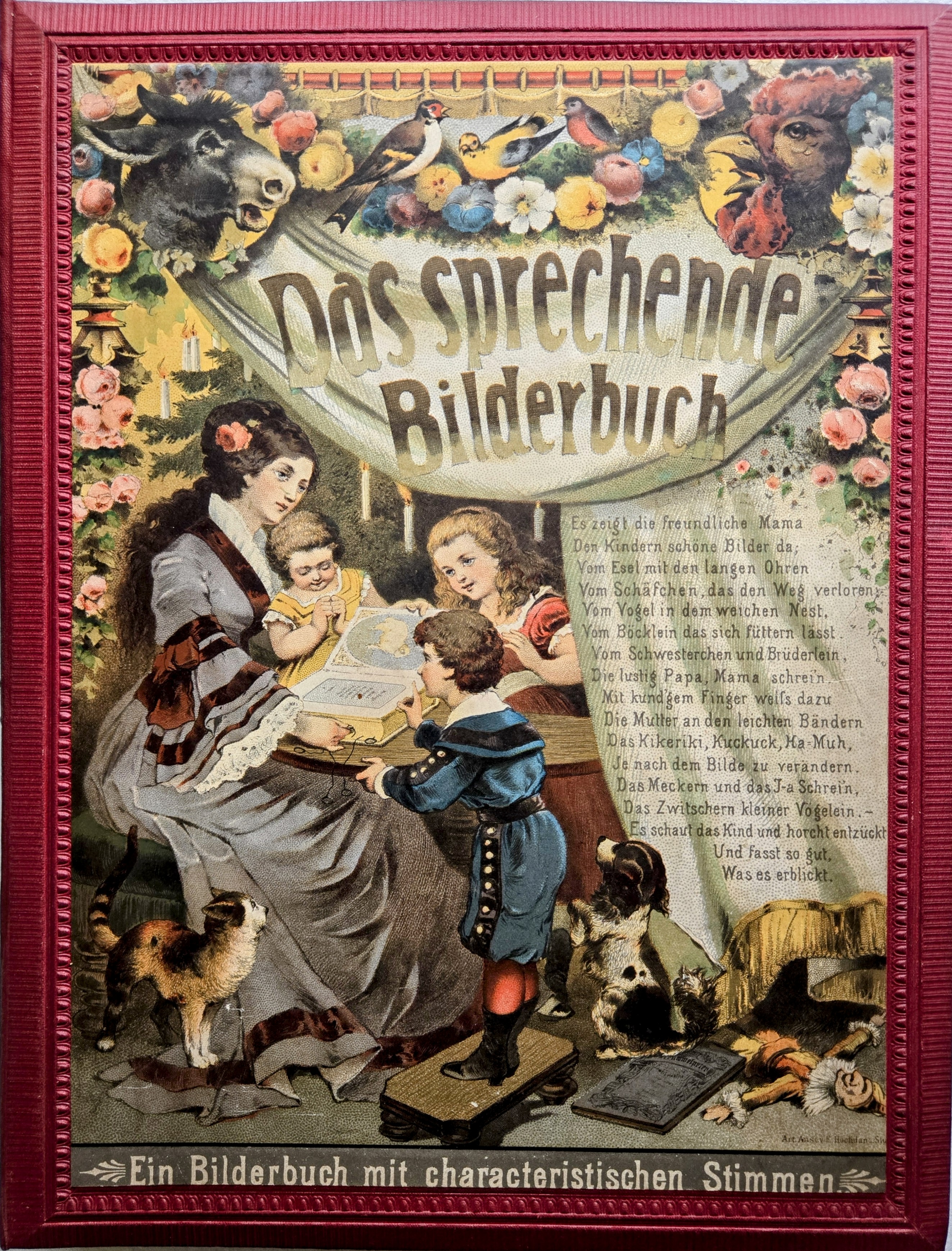 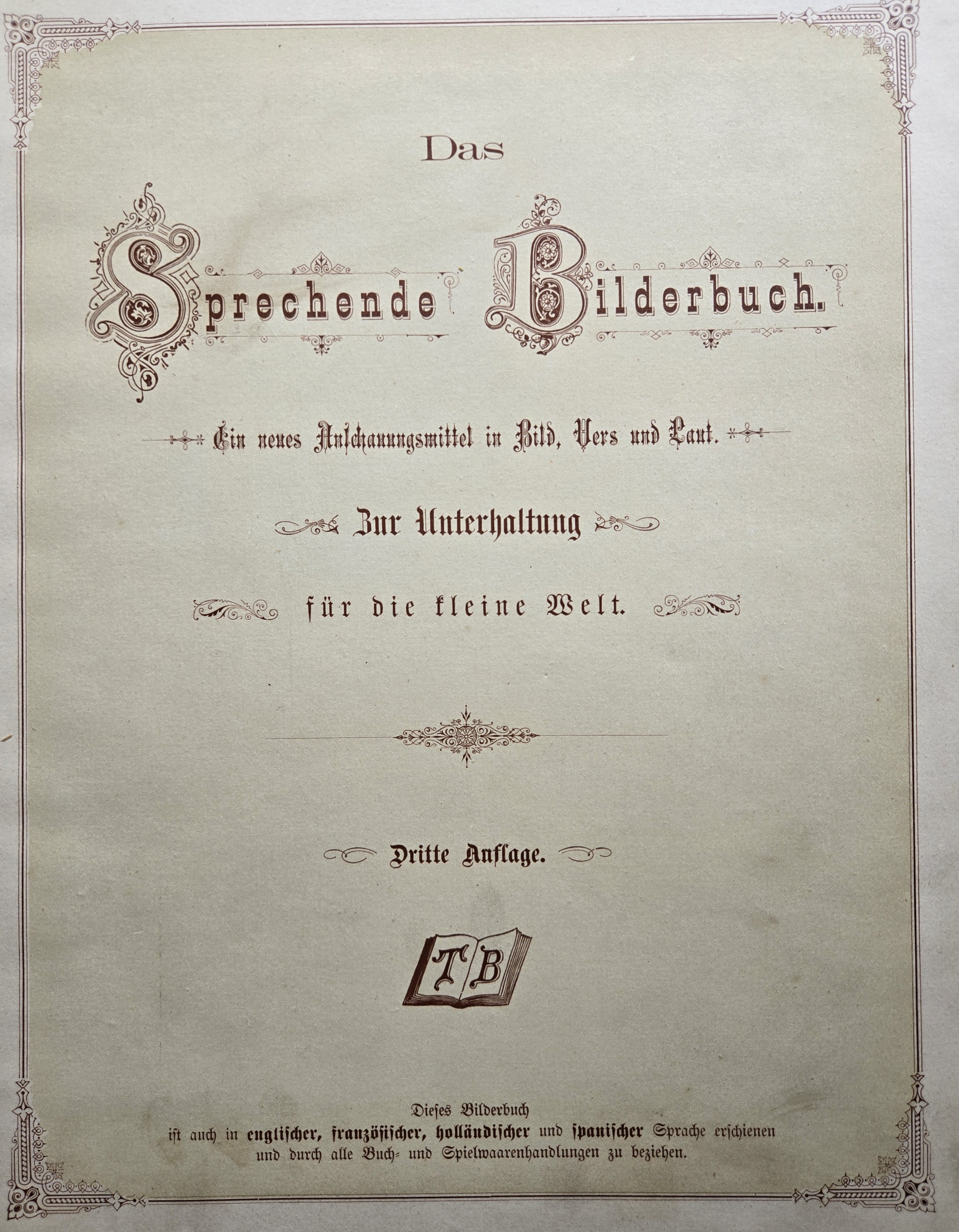 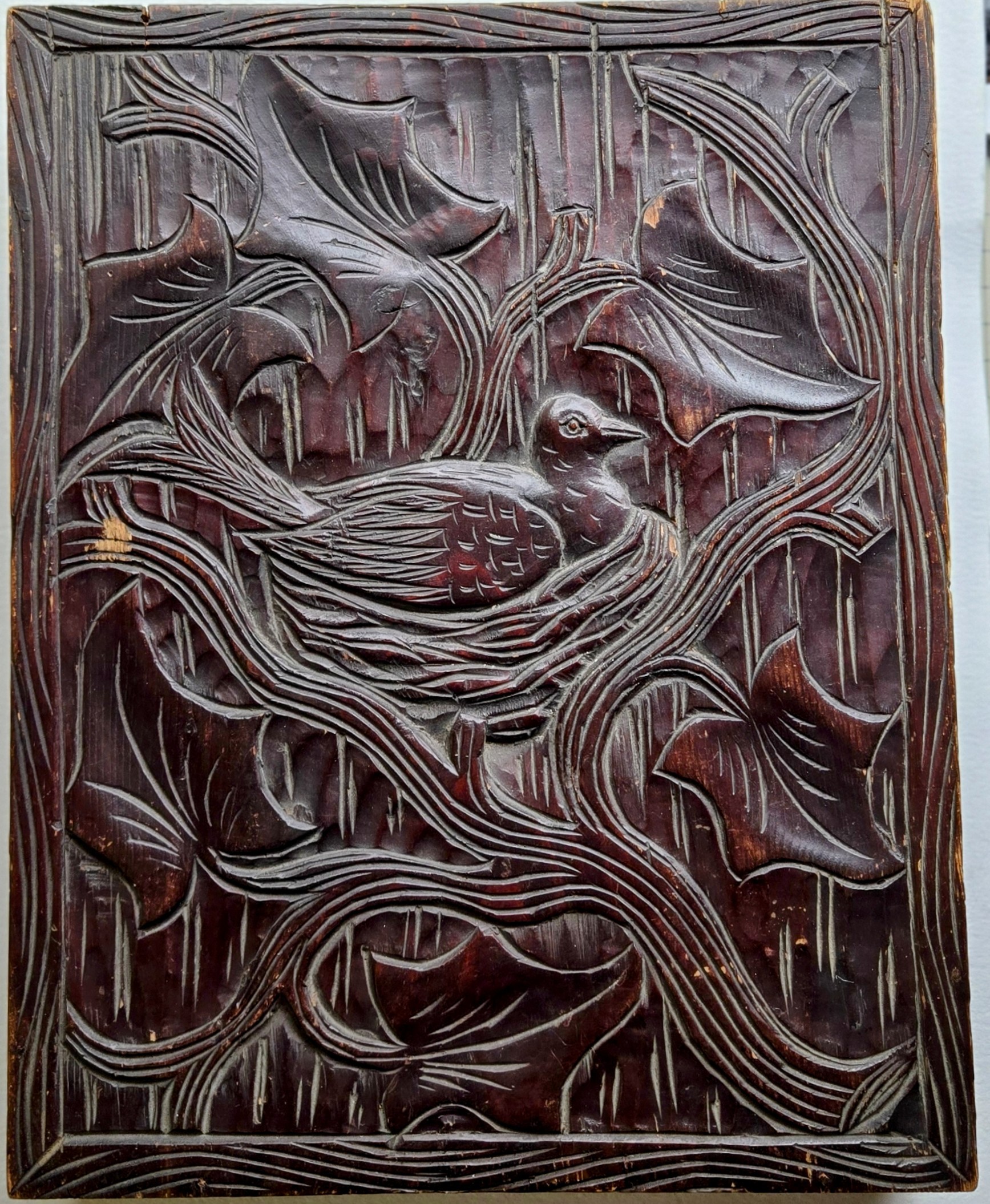 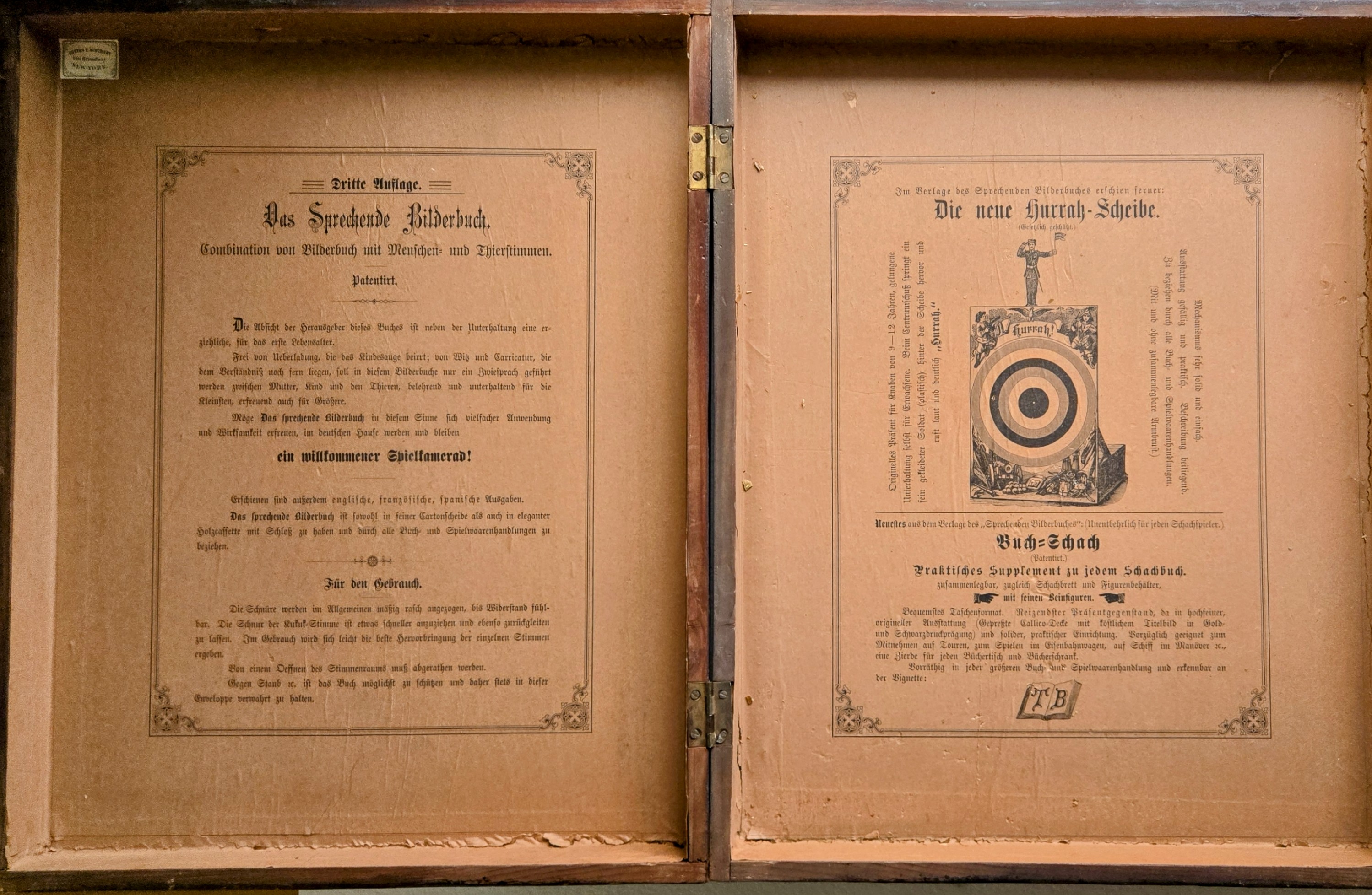
Overview
Das Sprechende Bilderbuch, or "The Speaking Picture
Book," was a German toy book created by Theodor Brand in the late 19th
century. This innovative children's book combined illustrations with mechanical
sound elements. The book operated using string-activated pulleys connected to
bellows inside a wooden box, which blew air into a series of reeds and pipes,
producing sounds corresponding to the animal illustrations on its pages. The
book’s original dimensions were
approximately 32 x 24 x 5.3 cm.
It was the most expensive moving children's book of its
time.
Theodor Brand’s Background, Patent, and International Distribution
Theodor Friedrich Otto Brand, born on March 4, 1847, in Hemeln near Hannoversch Münden, Germany, was a trained bookseller with a passion for inventive ideas. He worked at the Palm Association of Young Booksellers in Munich until June 1874 and was active with Theodor Ackermann in Munich, possibly gaining experience in publishing or related fields. Sonneberg was known as the
"world capital of the toy industry" in the 19th century, producing
various voice mechanisms for dolls and toys. Brand moved to this bustling town
in 1874 and, in 1878, secured a German Imperial Patent (D.R.P. 3652) for his
"Talking Picture Book." This patent ensured exclusive rights to
manufacture and sell the book in Germany and internationally.
Brand expanded his patent protection beyond Germany,
obtaining patents in the United States (December 30, 1879), England - shortly
after the U.S., and then Austria. The book was translated into multiple
languages, including English, French, Spanish, and Dutch, allowing for broader
international distribution.
Animal Voices: While the original German edition included
voices familiar to Central European children (e.g., cuckoo, goat, and rooster),
editions distributed in other countries sometimes featured region-specific
animals and sounds. In some regions, the illustrations were adjusted to reflect
local artistic preferences. For instance, while early German editions featured
traditional German folk art influences, later editions released in England and
France leaned toward Art Nouveau, aligning with contemporary trends in those
countries.
Note that: The Speaking Picture Book published by F.A.O.
Schwarz, New York, around 1893–95, represents an American edition intended for
the U.S. market. Despite being distributed by F.A.O. Schwarz, a prominent
American toy retailer, this book was still manufactured in Germany. It aligns
with the original production methods and design created by Theodor Brand in
Sonneberg.
In England, the publisher was H. Grevel & Co. - An old ad (1882) for this book in the UK states:" H. Gebhardt, located at 10, Coleman St., London, E.C. - Sole Agent for the United Kingdom." The designation "sole agent" indicates that the company was responsible for the exclusive distribution and sales of this particular book within the UK. This role typically involves marketing, sales, and distribution, rather than the actual publishing or production of the book.
The French title
is Le Livre d'images parlantes. Published by Kratz-Boussac, Paris
We have also seen another title in French: Livre Avec Voix D’animaux - an older ornate Art Nouveau one and a later smaller red cover one (similar to The Speaking Toy Book) - both published by Brand
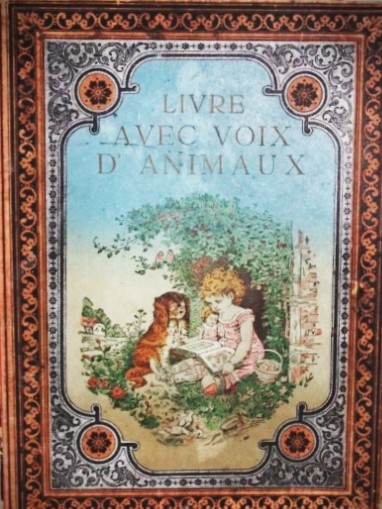
The Dutch title is Het Sprekende Prentenboek.
Initially published in 1880 by Sijthoff from Leiden, the book was later sold to
D. Bolle from Rotterdam, who released a different edition under his own imprint
in November 1881. The Dutch version differed significantly from the original
German edition. It featured six plates instead of the original eight and
included only two cords to pull, reducing the number of sounds compared to the
original nine. This version is often described as a "poor substitute"
for the more elaborate edition produced by Theodor Brand in Sonneberg. These
adaptations aimed to make the book more affordable, but in doing so, much of
the richness and interactive features of the German edition were lost. The image below is Courtesy of: Nationaal Archief, via Het Geheugen Source URL: Het sprekend prentenboek
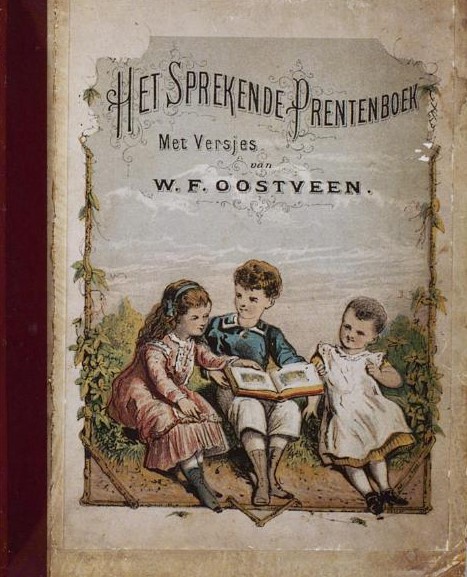
As of this update,we have been unable to locate a Spanish
edition. Collectors, please chime in 😊
Design and Functionality
The Sprechende Bilderbuch was not a traditional book
but rather a blend of book and toy. The majority of its structure was taken up
by a wooden box containing mechanical components, with only a small section
dedicated to written text and illustrations. Each sound was generated by a
small bellows mechanism that was activated by pulling a string. When the string
was released, the air was pushed out by a spring, creating realistic animal
sounds through various modulating tools.
The original German book featured nine double pages, with
each left-hand page displaying an illustration and the right-hand page
containing a short poem. A horizontal line on the page indicated which string
to pull to activate the corresponding sound. The 9 voices included:
Rooster, Donkey, Lamb, Bird's Nest,Cow, Cuckoo, Goat, Mama, Papa
Theodor Brand simply called his company by his name - here is his logo: (Note Logo varied with International Editions)
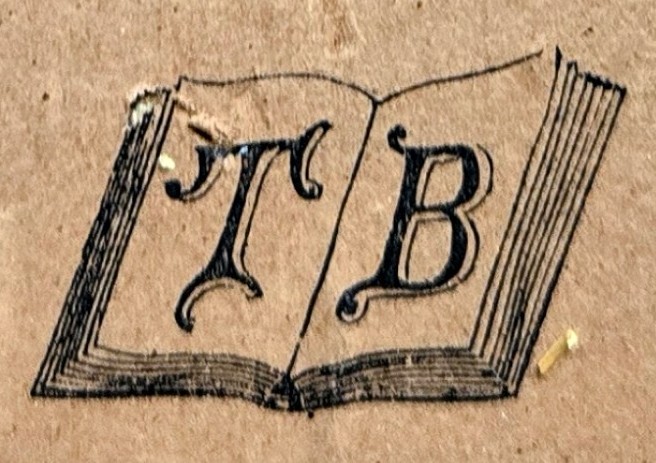
Development and Evolution
The initial editions of Das Sprechende Bilderbuch
featured simple, child-friendly verses, likely written by Theodor Brand’s
mother, paired with illustrations by painter J. Gottfried Franz (1845-1905).
These early versions were straightforward, with color lithographs produced by
the renowned "Art-Anstalt von E. Hochdanz" in Stuttgart.
As the years passed, the book's content became more
sophisticated. By the 16th edition, around 1906, the focus shifted. This shift
catered to an older audience, expanding the book's appeal —from simple
children's verses to a collection of poems and stories authored primarily by
prominent contemporary writers, including Johannes Trojan (1837-1915), Pauline
Schanz (1828-1913), and Frieda Schanz (1859-1944
In terms of design, the evolution was twofold. While the
content and illustrations grew more elaborate over time, reflecting the Art
Nouveau style popular during the early 20th century, there was also a
trend toward simplifying some editions to reach a broader market. For instance,
a smaller, landscape-format edition titled "Bilderbuch mit
Tierstimmen" Zur Unterhaltung für die kleine Welt. (Picture Book with
Animal Voices for Entertainment for the Little World) was introduced. This
17th edition was published around 1907. This version featured
simpler illustrations and fewer sound elements, making it more accessible and
affordable. Drawstrings included The cuckoo, the sheep, the bird's nest , the kitten, the goat, and the rooster. It
was available in two sizes: a smaller version measuring 22x18 cm with six
sounds and a larger one at 31x25 cm featuring nine sounds. The Speaking Toy
Book was another small version intended for export to English-speaking
countries and was published after 1910.
Thus, while some editions embraced more intricate designs
and sophisticated content, others were deliberately simplified to appeal to a
wider audience. It would go on to include about 20 editions in total. A copy of
the 19th edition is preserved in the Children's and Young Adult Book Department
of the Berlin State Library, cataloged under the signature 53 BB 500584 R.
Marketing and Reception
The Sprechende Bilderbuch was widely praised for its
innovative combination of art, literature, and mechanical sound. An article
from Illustrirte Zeitung (Volume 73, 1879) described it as a
"masterpiece" of Thuringian craftsmanship, bringing simple
illustrations and texts to life with authentic sounds. The book served as both
an educational tool and a source of entertainment, making it popular among
children and adults alike. It was originally advertised for children from one
to four years old.
The English edition, introduced in 1879, was advertised in
various publications like Papierzeitung (Volume 4, Page 691, 1879). An
ad described the book as a "highly original novelty" featuring nine
distinct voices. The book was sold in elegant wooden cases priced at M. 10.50,
with significant pre-orders from wealthy customers.
In the lead-up to Christmas 1880, Johannes Trojan, a German
writer and editor, published an anonymous laudatory essay in the
"National-Zeitung" about Das Sprechende Bilderbuch (The
Speaking Picture Book). His review likely contributed to the book's significant
sales during that period. Trojan praised the authenticity of the sounds,
particularly those of the cuckoo, cow, and nestlings, noting the effort
invested in their production. His positive review in a prominent publication
like the "National-Zeitung" likely enhanced the book's popularity
during the holiday season.
According to Buch- und Kunst-Katalog (compiled by
Adolph Russell, 1881), the German edition sold 1,000 copies within the first
eight weeks of release, showcasing its immediate popularity.
The Sprechende Bilderbuch was available in two
formats: a more affordable version in cardboard and a deluxe edition in an elaborately carved wooden case.
According to Deutsches Familienblatt (1880), the prices
were as follows: (Images from vintagepopupbooks.com)
- Cardboard
version: 10 Marks See this early version on right and a later cardboard version on left. See early transcribed at bottom of article
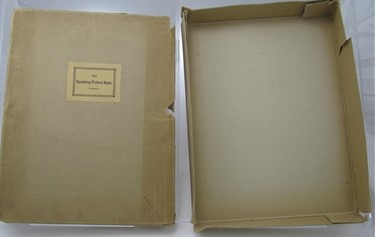 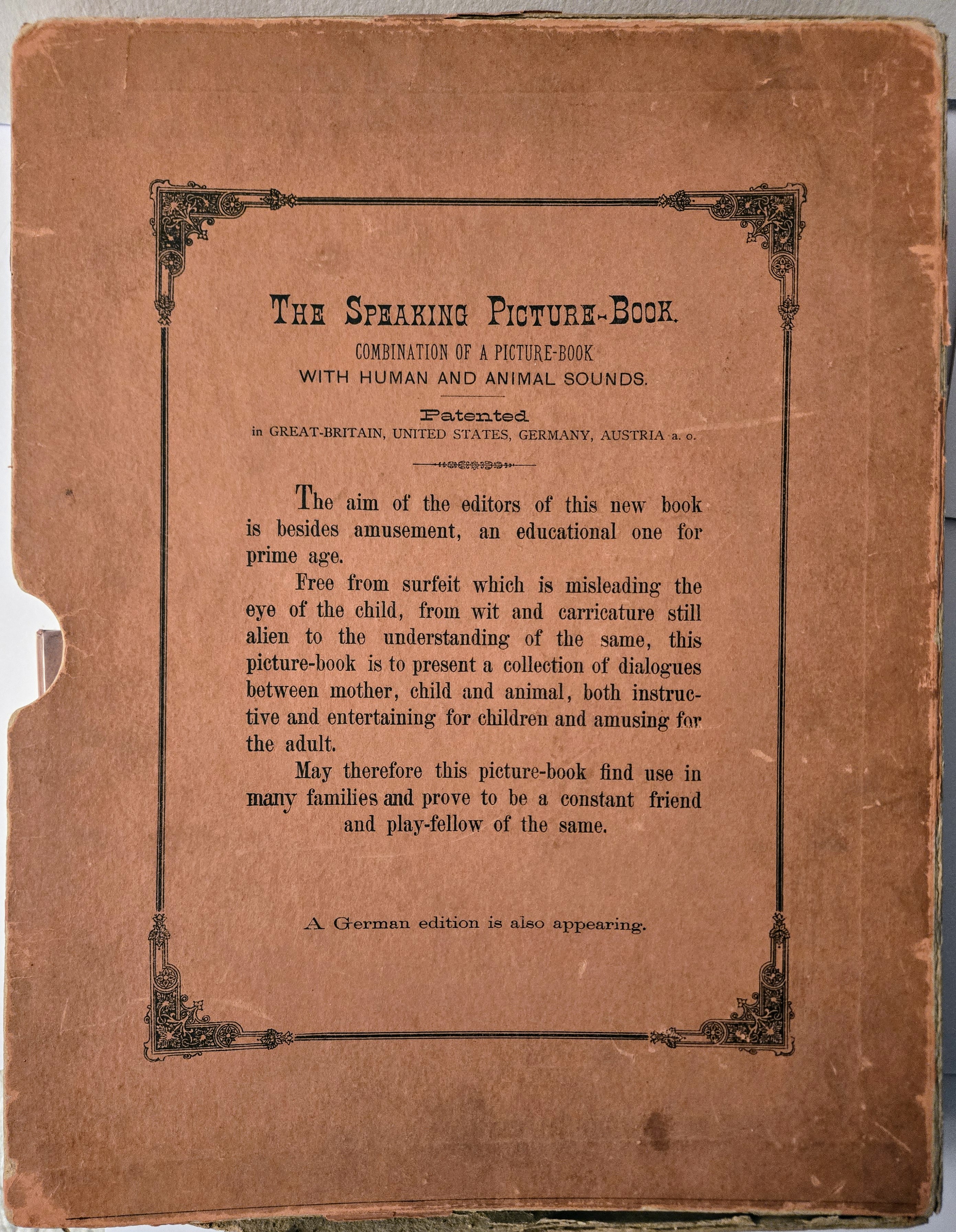 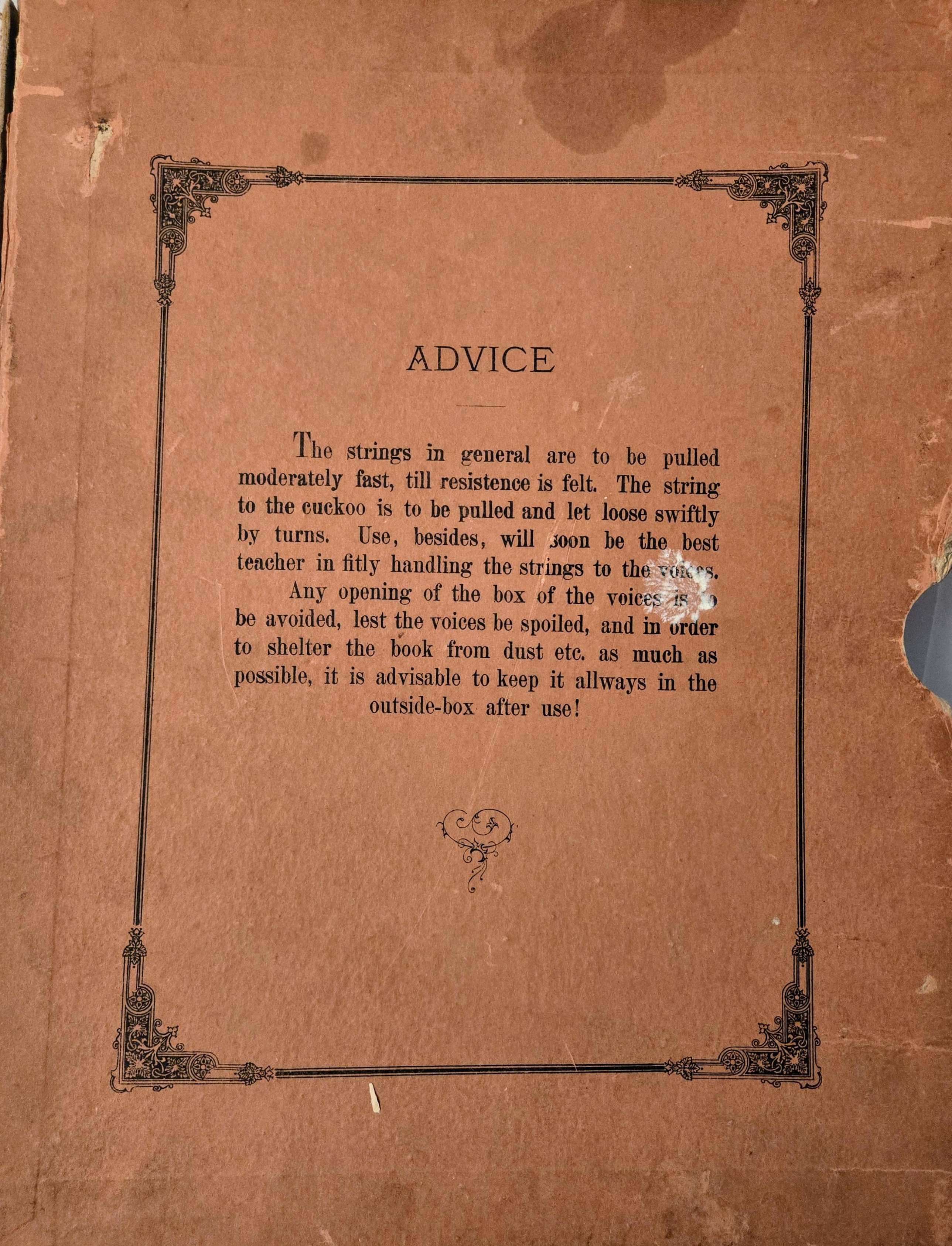
purchase or see more info here: https://www.vintagepopupbooks.com/The-Speaking-Picture-Book-p/a-29.htm
- Wooden
case version: 12.50 Marks
 
3rd edition with original wooden box - Image from the vintagepopupbooks.com collection. Inquire at [email protected]
These editions were marketed as luxury items, especially the
version in the wooden case, which was considered an elegant and durable gift.
An advertisement from Papierzeitung (Volume 4, Page 691, 1879)
highlighted the craftsmanship of the book, emphasizing its unique combination
of art, literature, and mechanical sounds, making it a premium product for
affluent families.
Note the inside back of the wooden box - the text consists of ads for their other products. We have translated the text for both the front and the back at the end of this article after the reference section.
Technical Details of Sound Mechanisms
In the late 19th century, the production of Das
Sprechende Bilderbuch (The Speaking Picture Book) in Sonneberg, Germany,
involved specialized craftsmen known as Balgmacher (bellows makers) and Stimmenmacher
(voice makers). The Balgmacher were responsible for crafting the bellows
mechanisms that produced sounds in toys and books, while the Stimmenmacher
focused on creating more intricate voice mechanisms for dolls and other
interactive toys.
Notable early voice manufacturers in the Sonneberg region
included Hensold in Neustadt and Christoph Motschmann. Motschmann
was granted a German patent on April 29, 1857, for a "Mama/Papa"
voice mechanism designed for dolls. This innovation allowed dolls to emit
sounds resembling human speech, enhancing their realism and appeal.
Collectibility
Haining, Peter (1979). Movable Books: An
Illustrated History. New English Library Ltd. States:
‘The piece de resistance of any collection of movables, or
toy books for that matter, is surely The Speaking Picture Book (c. 1893), an
item of such charm and fascination that even the most blasé modern parents or
their children can hardly fail to be captivated by it. Stored in an ordinary
brown cardboard box, this ‘Special Book with Picture, Rhyme, and Sound for
Little People’ is a delight to handle, eye-catching in appearance, and quite
remarkably authentic in the sounds it produces.’
The book was produced in limited quantities, especially in
its original format with a wooden box. The fragility of the bellows mechanism
and the materials used (wood, fabric, and paper) mean that few intact copies
have survived. Over the years, many editions were lost, damaged, or
disassembled, making complete, functioning examples exceedingly rare.
Additionally, the British Library holds a copy of The
Speaking Picture Book in its collection, indicating its recognized
importance in the history of children's literature and movable books. The
library notes that the book is "a rare and delightful example of a late
19th-century interactive children's book."
Legacy and Aftermath
Following Brand's death in 1911, his widow managed the
business until 1919, when it was sold to Georg Möller, a prominent toy
manufacturer and exporter.
After Theodor Brand's company was sold to Georg Möller in 1919. (wife Bernhardine, née Wachter) He was located at Robertstr. 34-36, in Sonneberg. Production of Das Sprechende Bilderbuch continued under Möller’s management. Möller, a prominent toy manufacturer and exporter, maintained the established formats of the book until 1929. This period saw the continued success of the book, although the designs and production methods likely reflected Möller’s influence and adaptations for changing markets. By the late 1920s, additional manufacturers, such as Albin Matthäi (AMA) in Judenbach, began producing similar sound picture books. Albin began
producing sound picture books, securing additional patents in 1928 to simplify
the manufacturing process. Albin Matthäi’s company, founded by his father Carl
Friedrich Bernhard Matthäi, initially focused on crafting sound mechanisms for
toys, dolls, and picture books. These new, cost-effective designs replaced the
earlier slide mechanisms with printed sound devices, which were inserted
between two cardboard pages. The sound was emitted through a hole aligned with
the illustration. This format remained in production well into the early 1960s.
Albin Matthäi’s company, founded by his father Carl
Friedrich Bernhard Matthäi, initially focused on crafting sound mechanisms for
toys, dolls, and picture books. By 1928, the company expanded, employing around
12 workers and producing novelty sound items and voice cards. Their products
reached international markets, with exports to Great Britain, Denmark,
Australia, and beyond. However, the Great Depression led to a gradual decline
in demand.
Following World War II, under East Germany’s socialist
regime, the company was restructured into a cooperative. Despite these changes,
they continued producing talking picture books until approximately 1965.
References
- Hofmann,
Ernst. The "Talking Picture Book" and its Inventor Theodor
Brand, TUDpress Study Texts on Language Communication Volume 92, 2018.
Note: R. Hoffmann's 2015 study, Voices for Toys – First
Commercial Spin-offs in Speech Synthesis, further explores the early
integration of mechanical voices in toys, illustrating how Theodor Brand's
invention paved the way for modern multimedia and interactive books.
- Hoffmann,
R. (2015). Voices for Toys – First Commercial Spin-offs in Speech
Synthesis. Proceedings of HSCR 2015.
- Illustrirte
Zeitung, Volume 73, Page 477, 1879.
- Papierzeitung,
Volume 4, Page 691, 1879.
- Buch-
und Kunst-Katalog, compiled by Adolph Russell, 1881.
- Wikipedia
contributors. "Christoph Motschmann." Wikipedia, Die
freie Enzyklopädie, 18 November 2023, https://de.wikipedia.org/wiki/Christoph_Motschmann.
Accessed 18 November 2024.
- Pirckheimer
Gesellschaft. "Das Sprechende Bilderbuch." Pirckheimer-Gesellschaft,
https://pirckheimer-gesellschaft.org/blog/das-sprechende-bilderbuch.
Accessed 18 November 2024.
- Gielen,
Theo. "Dutch Movables in the 19th Century." Movable
Stationery, vol. 9, no. 2, May 2001, p. 10.
- He
worked at Palm until June 1874 and was active with Theodor
Ackermann in Munich from Palm. Association of Young Booksellers in
Munich: The History .... Google Books, 1884, p. 71.
- "Toy Museum Sonneberg: Little History of Play." Entdecke Deutschland. Accessed November 19, 2024. https://entdecke-deutschland.de/en/bundeslaender/thueringen/toy-museum-sonneberg-little-history-of-play/
- Muller's Wife Bernadine: Deutsche Spielwaren-Zeitung: For the Toy Industry, Volumes 23-24, 1931, page 48.
Perry & Co's Monthly Illustrated Price Current, Volume 15, Perry and Co., Ltd., 1882. Accessible via Google Books. - (British Agent)
Translations of the German edition of the Speaking Picture Book title page and the inside front and back of its wooden box. From the vintagepopupbooks.com collection:
Title Page of the Book itself:
The Speaking Picture Book.
A new visual medium in image, verse, and sound.
For the entertainment
of the little world.
Third Edition.
(TB logo with an open book)
This picture book
has also been published in English, French, Dutch, and Spanish
and can be obtained through all book and toy stores.
Wooden box – inside front :
Third Edition.
The Speaking Picture Book.
Combination of Picture Book with Human and Animal Voices.
Patented.
The intention of the publishers of this book is, in addition
to entertainment, to provide an educational benefit for early childhood.
Free from excess, which confuses a child's eye; from wit and caricature, which
are still beyond their understanding, this picture book is meant to create a
double bond between mother, child, and the animals—educational and entertaining
for the little ones, refreshing even for older children.
May The Speaking Picture Book in this spirit find
frequent use and benefit, remaining and staying in German households as
a welcome play companion!
Additionally, English, French, and Spanish editions have
been published.
The Speaking Picture Book is available both in a fine cardboard box and
in an elegant wooden case with a lock, and can be obtained through all book and
toy stores.
For Use.
The strings are generally to be pulled moderately quickly until resistance is
felt. The string for the cuckoo sound should be pulled somewhat faster and also
allowed to glide back in the same way. Through use, the best way to produce
each voice will easily be learned.
Pulling the strings with excessive force must be avoided.
The book should be protected as much as possible from dust, etc., and therefore
always kept in its envelope.
Inside the back of the wooden box:
The inside back page serves as an advertisement for other
toys and games produced by the same publisher. It highlights additional
products such as the "new Hurrah-Scheibe" (target game) and
"Buch-Schach" (book-chess set), describing their features and practicality.
This includes an ad for their chess set:
Latest from the publisher of the "Speaking Picture
Book": (Indispensable for every chess player.)
Book=Chess
(Patented.)
A practical supplement to every chess book.
Foldable, simultaneously a chessboard and figure container,
→ with fine stone pieces. ←
Most convenient pocket size. Most charming gift item, due to
its exquisite,
unique design (Embossed Calico cover with delightful title image in gold
and black embossing) and sturdy, practical structure. Especially suitable for
traveling, for playing in a train car, on a ship, during maneuvers, etc.,
an ornament for every reading table and bookshelf.
Available in every major book and toy store and identifiable
by the vignette:
(TB logo with open book)
AD FOR ANOTHER TOY:
Translation (English):
Mechanism very solid and simple.
Design appealing and practical. Description enclosed.
Available through all book and toy stores.
(With and without foldable crossbow.)
AD FOR A SOLIDER TOY:
Translation (English):
Latest from the publisher of
A unique gift for boys aged 9–12 years, successful entertainment even for
adults.
Upon a bullseye shot, a finely dressed soldier (in relief) jumps out from
behind the screen and shouts loudly and clearly, "Hurrah."
( Note: The "Hurrah" Game was a target game designed for all ages. It featured a target approximately 18 inches tall and 12 inches wide. When the bull's-eye is hit by a ball or arrow, a figure at the top springs forward and enthusiastically exclaims "Hurrah!" in a realistic manner. The game came in a cardboard box and was sold in sets.)
AD FOR A HURRAH DISK
Also published by the publisher of the Speaking Picture
Book:
The new Hurrah Disk.
(Legally protected.)
IMAGE IN THE MIDDLE:
The image in the middle of the page features a target-like
design, with concentric circles resembling a bullseye. Above the bullseye,
there is a soldier-like figure (or possibly a toy figure) depicted saluting or
raising one hand. Around the bullseye, the word "Hurrah!" is
prominently displayed in a banner-style design. The lower portion of the target
is surrounded by decorative elements, including illustrations of toys,
household objects, or scenes that add a sense of context.
This image directly relates to the accompanying text, as the
text discusses "Die neue Hurrah-Scheibe" (The New Hurrah-Disc), which
appears to be a novelty or toy mechanism likely designed for entertainment,
possibly a target-shooting game. The "Hurrah!" inscription and the
image of the soldier suggest a theme of celebration or triumph. Based on the
description of mechanisms and accessories, this could be an interactive feature
of a toy or game, where hitting the target or activating a specific mechanism
would produce a sound or visual effect such as the exclamation
"Hurrah!".
EARLY CARDBOARD COVER TRANSCRIPTION
THE SPEAKING PICTURE-BOOK. COMBINATION OF A PICTURE-BOOK
WITH HUMAN AND ANIMAL SOUNDS. Patented
in GREAT-BRITAIN, UNITED STATES, GERMANY, AUSTRIA a. o.
The aim of the editors of this new book is besides amusement, an educational one for prime age.
Free from surfeit which is misleading the eye of the child, from wit and caricature still alien to the understanding of the same, this picture-book is to present a collection of dialogues between mother, child and animal, both instructive and entertaining for children and amusing for the adult. May therefore this picture-book find use in many families and prove to be a constant friend and play-fellow of the same. A German edition is also appearing.
|